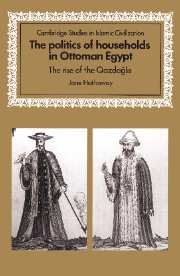Book contents
- Frontmatter
- Contents
- Note on transliteration
- List of illustrations
- List of tables
- Preface
- List of abbreviations
- Genealogical tables
- Introduction
- I The household and its place in Ottoman Egypt's history
- II Qazdağli household-building strategies
- Chapter 6 Marriage alliances and the role of women in the household
- Chapter 7 Property and commercial partnerships
- Chapter 8 The Qazdağlis and the Chief Black Eunuch
- Chapter 9 Conclusions
- Glossary
- Bibliography
- Index
Chapter 8 - The Qazdağlis and the Chief Black Eunuch
Published online by Cambridge University Press: 22 September 2009
- Frontmatter
- Contents
- Note on transliteration
- List of illustrations
- List of tables
- Preface
- List of abbreviations
- Genealogical tables
- Introduction
- I The household and its place in Ottoman Egypt's history
- II Qazdağli household-building strategies
- Chapter 6 Marriage alliances and the role of women in the household
- Chapter 7 Property and commercial partnerships
- Chapter 8 The Qazdağlis and the Chief Black Eunuch
- Chapter 9 Conclusions
- Glossary
- Bibliography
- Index
Summary
The household, as we have seen, encompassed a network of alliances that could link men and women in a wide variety of activities and in far-flung locales. The Qazdağlis used a variety of commercial and conjugal alliances to cement their authority within Egypt and the Hijaz. It was imperative, however, for them to extend their household alliances beyond their immediate vicinity in order to cultivate ties with the various powers at the imperial center: those who were in a position to appoint a friendly governor to Egypt or, on the other hand, to order the seizure of the Qazdağlis' estates. In building these bonds, the Qazdağlis and their imperial allies exploited the household as a channel of exchange between Egypt and the imperial center. For it was principally by affiliating with local households or co-opting local grandees into their own households that imperial functionaries exerted influence in the provinces.
Of all imperial appointees who carried weight on the local scene, one stands out for exploiting the household in this fashion. This is the Chief Black Eunuch of the Ottoman imperial harem, known as Kizlar Ağasi or Darüssaade Ağasi. The use of eunuchs in imperial inner sancta dates to remote antiquity; the Persian, Roman, and Chinese empires all practiced the custom. The Ottomans had begun to employ harem eunuchs in the early days of their empire. Ottoman harem eunuchs included black Africans imported from the eastern regions of sub-Saharan Africa and whites imported primarily from the Caucasus.
- Type
- Chapter
- Information
- The Politics of Households in Ottoman EgyptThe Rise of the Qazdaglis, pp. 139 - 164Publisher: Cambridge University PressPrint publication year: 1996



